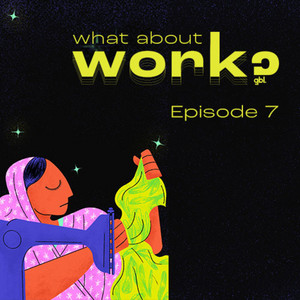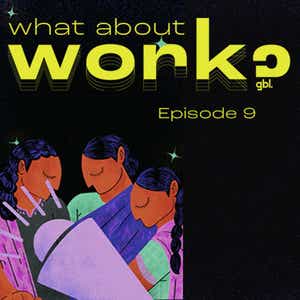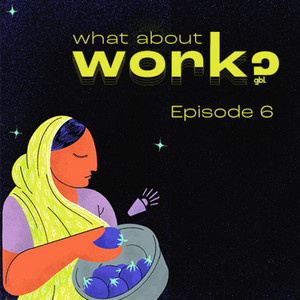Listening to your workers on factory floors can not only make them feel heard but also drive dialogue, productivity, and progress. Join us in our new episode of What About Work?, where co-founders, Associate Director of Research and Data, and Senior Design Manager at GBL talk about the importance of worker voice and breaking down the barriers that hold them back.
Transcript
Hello! And welcome to What about work? An audio series produced by Good Business Lab.
Good Business Lab or GBL seeks to globally transform the lives of low-income workers through rigorous research and evidence-based solutions.
What about work? talks about the past and current experiences of workers in labor-intensive industries and other emerging sectors across geographies. Be it garment, automobile, fast food, platform gig work or any other.
In episode 8, we will be exploring a crucial part of industrial environments: worker voice.
Historically, the factory has been a site of conflict between workers and management.
Achyuta A: what you get is in equilibrium, a culture where Workers are rarely sort of listened to
Anant N: You feel invisible you’ll hear more from economists and GBL’s co-founders, Achyutya Adhvaryu and Anant Nshyadham.
Worker voice is integral to any workplace. Many people tuning in right now may have at one point or another felt frustrated if their opinions or complaints were not taken seriously. For firms, workers can provide valuable insight because of their direct contact with day to day operations.
With pressures running high on the factory floor, it becomes imperative to preserve and encourage worker voice. Especially for women working in garment factories.
Professor of Economics at University of California San Diego, and inaugural Director at the university’s 21st century India Center, Achyuta Adhvaryu is also GBL’s Chief Development Officer. He says,
Achyuta A: if you’re a low income woman, you know, particularly one who comes from a historically disadvantaged kind of background or, you know, caste you might never have had that kind of voice within your household, within your spousal relationship. 6:58 And so when you come to the workplace, that norm kind of carries over, where a lot of workers, you know, just feel like they can’t speak up and suggest anything that’s sort of out of the realm of possibility.
In an article for the Harvard Business Review, Achyuta and Anant along with Associate Professor of Economics at University of Hawaii, Teresa Molina wrote that they
discovered that the period around these annual wage hikes is particularly turbulent: worker dissatisfaction tends to be high following the wage hike, despite the fact that workers end up receiving larger paychecks. We hypothesized that workers might be dissatisfied after the wage hike because they were expecting larger wage increases than they actually received.
Chief Strategy Officer at GBL, Anant Nshyadham who is also Associate Professor at University of Michigan dives deeper.
Anant N: We kept hearing from the firm that you might want to navigate around this time because the whole industry and multiple industries and so on have this kind of turmoil during this time the minimum wage increments get announced. And there’s a lot of attrition and turnover and as economists, this sort of thing left us scratching our heads. Because it seemed like what you’re telling me is that at this time you tell workers that you’re gonna pay them more and then they get really upset and leave. And so that was kind of a puzzle that we definitely wanted to unpack.
So what did this simple puzzle unravel?
Blue collar workers often feel like they have no voice in their workplace. GBL conducted an exercise to actively listen to workers.
workers were asked to participate in an anonymous survey, which asked for their feedback on various aspects of the job.
The survey yielded some obvious yet fascinating results. Want fewer workers to quit? Listen to them talk about work!
Now there are some mechanisms that firms may already have in the workplace. Even your job might have some of these. Suggestion boxes. HR reps. Ombuds. POSH committees. Worker committees. Union leaders. But the usage of many of these for low-income workers is complicated.
Smit G: Usually when suggestion boxes are placed in specified there as physical boxes that are present which are usually locked, somebody can go and put their kind of complain on sheet of paper on it.
That’s Smit Gade Associate Director of Research and Data at GBL
And what usually happens is that once somebody puts those complaints in, these are like a sheet of paper, they are written down whatever they have to say. Usually for many factories, they have a predetermined date on which these complaints get open and then factory HR or who is responsible will act on it. What ends up happening is there’s no accountability as such. So if I have sent a complaint, I have no knowledge of what is happening on that complaint, right?Because there’s no way I can directly go and ask what is happening? And given that I have said send this anonymously. So I am not sure what’s happening, whether my issue is resolved or not, right? There’s no accountability part that it gets built in both from the top of the factory management, as well as the workers who are sending perspective.
Arvind Patil, Senior Design Manager at GBL, adds that
Arvind P: So if you have to register your complaint via a suggestion box or complaint box, you should know how to write. And many workers, they are not highly literate, they don’t have confidence to write what they are feeling or sometimes they are not equipped to translate their experience in the textual format? So that is one limitation, the second limitation or drawback in suggestion boxes is time span. The turnaround time is really long, like 3 to 4 weeks is a really really long time to respond to workers queries.
Collective representation through unions is one of the most important support systems for workers. But some workers may feel their situations are not severe enough to go that route. On the other hand, speaking to HR and other management point people directly may be seen as having negative repercussions. For women, this carries baggage. It can put them in an extremely tenuous and vulnerable situation.
Achyuta A: workers often don’t have a voice both within society, more broadly, but also in their workplaces. If you’re a sort of a low income woman in India, you know, particularly maybe one who comes from a historically disadvantaged kind of background or, caste you might never have had kind of that voice within your household, within your spousal relationship. A lot of workers just feel like they can’t speak up and suggest anything that’s out of the realm of possibility. And similarly management has this sort of norm that, well, we don’t really take suggestions from workers, So it’s a norm shift that’s required to say, actually, workers having a voice giving feedback, having a dialogue and a relationship is potentially productive.
Anant N: The reality might be something really simple that the machine is, has a problem and the worker really doesn’t even though they know that they don’t feel comfortable saying it or that they have a health issue that they need to solve and come back and the firm should care. 9:58 So all of these little simple issues add up, we realize that they’re really, when we started doing this, unpacking, some of these issues were so easy to solve. Oh, the bathroom never has soap in it and that was something that made workers really frustrated, and feel like they weren’t being taken care of. But it’s such a simple thing that the firm could do or a lot of issues were, oh, the, the worker didn’t get their pay. There was some glitch in the payment process that would be a major, kind of compliance issue for them. But they just don’t know because there’s like 100,000 workers and they didn’t realize that there was this issue, those simple things can be reported much more easily. if you have some mechanism to, you know, hear the voices of individuals.
There is a need to address the gaps in open communication between employers and workers. Especially in large labor-intensive contexts which sees hundreds of workers spread across a few buildings.
Arvind P: So from an inclusion perspective, it becomes important to understand what your employees are feeling? If you understand what they are saying, what they’re feeling, then you can take a proactive measure, then you can reciprocate which is why worker voice becomes an important part of your organizational culture.
Workers can also be a powerful source of information on day to day operations. We see the workplace in a very granular way. A lot of the times the scale of production can obscure managerial perspective. Painting a big picture can make you lose sight of the tiny details.
B Renukaprasad, Senior Ventures Manager, at GBL says,
B Renukaprasad: We’ve noticed that a worker’s voice can enable the workers to suggest the right kind of things that can be implemented on the shop floor. They work on these aspects on a day to day basis. They can suggest things that can improve the processes, the productivity and different aspects of the whole operation. So that’s what I feel, the worker voice is. It’s meaningful communication at the end of the day and, and that in turn creates a positive change and adds a positive factor to this whole communication is what I feel.
That’s why after conducting rigorous research Good Business Lab is developing Inache, a two way communication tool designed to facilitate dialogue between workers and management in labor-intensive contexts.
Arvind P: It’s not just about addressing their grievances, it’s about capturing their inputs, their suggestions, using or leveraging their lived experiences or wisdom to enhance your organization’s processes. So this is the importance of worker voice. I just don’t see it as a problem solving tool. I see it as a mechanism through which you can create value for your organization.
While conducting research on worker voice, we showed blue collar workers in the country’s garment industry images to gauge how they feel in the factory. Lavanya Garg, Associate Director of Partnerships and People Operations at GBL, wrote in a recent article about Inache that,
Lavanya G: The most relatable and prominent image chosen was that of a squirrel. The squirrel if we observe works in harmony with its environment. This is in fact how workers saw themselves in the factory setting! Our goal with Inache is to see what works, what doesn’t — and fine tune the tool. So that next time we talk to a worker in an Inache factory, while they see themselves to be in harmony with the environment, the environment is in harmony with their needs too.
Arvind P: What I realized is we are in the process of designing something that can transform the culture, work, culture of the soft floor, right? So how exactly can we create a harmonious workplace, a safe workplace for the factory workers? So as a researcher, there was a challenge for me and I have this hypothesis that it’s really difficult for us to articulate our intense experiences or difficult lived experiences? How can we make workers feel comfortable so that they can share their difficult experiences? So we used some images so that they can work as a nudge and workers can share their lived experiences. So there were a couple of key things that emerged. So how workers see their work. So they see it as a transformative experience like a woman who has, who has not even completed her 10th grade schooling, but still she is supporting her family. So it’s a very transformative experience for her. Second point was a major recurring theme was work as a resource. So they are not just earning money, they are earning relationships, they are earning stories, those stories serve as a memory and this becomes a really huge resource for them as an individual. So work as a resource, not just on a monetary front 19:58 And the third most important part was balancing act. So balance was a major metaphor or recurring theme in the synthesis. So all these women, they, they take care of their families and then they come to the factory, they work and they go back and again So these were the three key metaphors that we derived.
Transformation. Resourcefulness. Balance. Three things that workers carry with them in low-income contexts. So of course a tool designed to center their voice should hold the same values. The tool allows workers to call or share a voice message with a tech-enabled number. The case is then assigned to specific resolution-oriented staff. Smit delves into why this purposeful intervention might be better than traditional industry mechanisms.
Smit G: So the way the suggestion boxes would do it is that you can just, there’s a suggestion box, you can drop some complaint anonymously, which is great. But then there’s another aspect of two way communication, right. So for example, if somebody sends a complaint and there is some information which is missing. It’s not possible for factory managers to kind of go back and ask that person for this particular bit of information. So with technology, we are able to do both, because the technology now masks the phone number, if somebody sends a message or the hr manager can ask them for more information without actually knowing the number where technology at the back end is kind of facilitating this conversation.
Arvind P: Sometimes what workers did, they just used to send blank messages or blank calls or messages with hi, hello, good morning and so on. So they were just testing how exactly the system is responding, right? So instead of rejecting those kinds of inputs, we categorize those inputs as miscellaneous cases. And we reached out to the workers that OK, you have sent us this message. Would you like to share any grievances? Would you like to suggest something to us or are you facing any problems? Such empathetic messages were sent to the workers. So these kinds of simple interventions helped us in creating this trust in the system because workers identity should be protected.
Recent global crises like the pandemic have also shown the value of open-ended communication channels.
Achyuta A: when COVID hit and, everything shut down. It was actually instrumental at least anecdotally from the workers and the factory staff point of view, communicating directly with workers at a time when no one could see each other face to face. There’s like, extreme curfews as everybody remembers and, nobody was going to the workplace, everyone was staying in their homes, there was mass confusion over what people should do, what they shouldn’t do, who should they interact with, should they go home? Should they stay? all these questions, you know, migrants were stuck in, in cities and couldn’t get back to their villages. And the tool was actually just really useful as a communication modality for getting out mass messages to workers and also having workers being able to communicate directly with hr who still had access to the dashboard. So that was, you know, one positive note of rolling this out during COVID was that it provided this kind of valuable service that workers could use.
Getting information out to workers and from workers can be transformative for a firm. But it doesn’t have to stop there.
Anant N: there’s actually quite a lot of uses that we’re, we’re kind of just beginning to open, you know, the door to as we kind of scale in and begin to learn about how firms are actually using it, that are potentially powerful for work.
Next time, we will hear more about the nitty gritties of the tool, and the countless possibilities it offers for the future of blue-collar work. We will also have on the episode, low-income women workers airing their thoughts about Inache and case reporters who manage suggestions and conflicts that arise within labor-intensive contexts. So see you next time for the last episode of What about Work? Season 1!
Thank you for listening to What about work?.
We always welcome constructive feedback. Have anything you want to say? Drop us a message @goodbusinesslab on Twitter, Instagram, or LinkedIn. You can also visit our website goodbusinesslab.org to learn more about our approach to worker wellbeing.


